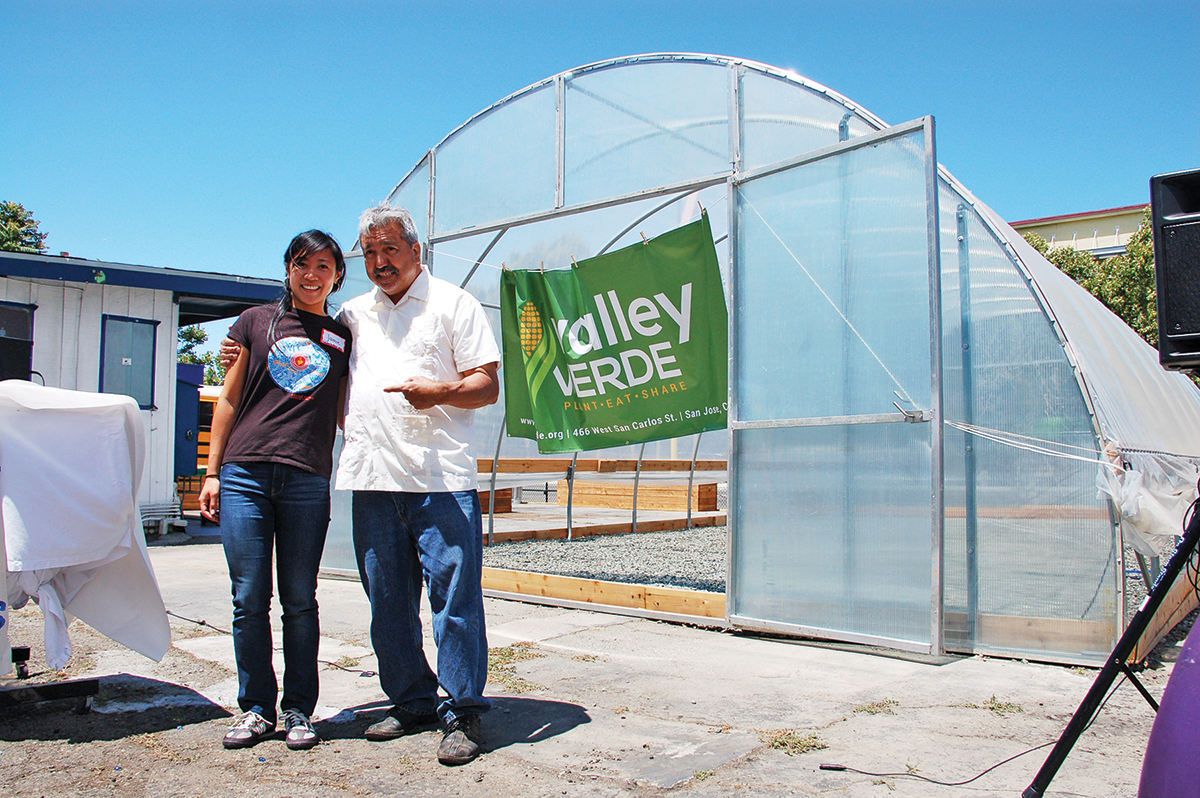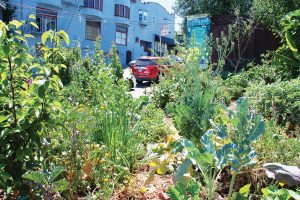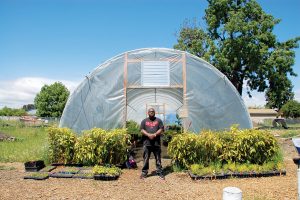
Raul Lozano had been searching for three years before he found what he was looking for in an abandoned used-car lot in San José. Lozano is the founder and director of Valley Verde, a nonprofit organization that provides support to low-income families who want to grow food in their own backyards. After the one-year program, graduates are encouraged to return to Valley Verde for starter seedlings, which in future will be sprouting in a new greenhouse on the formerly vacant lot that Lozano discovered on West San Carlos Street.
The lot’s owner, architect Thang Do, offered the lot at $1 a year to Valley Verde when he heard Lozano was looking for a site to build a demonstration garden and greenhouse.
The transaction was the first in San José to take advantage of the Urban Agriculture Incentive Zones (UAIZ) program, enacted through 2014’s Assembly Bill 551 (Ting), and adopted in 2015 by Santa Clara County and in 2016 by the City of San José. Inspired by the Williamson Act, which offers tax relief for rural agricultural land, the UAIZ program offers a property tax reduction to landowners who commit their land to urban agriculture for at least five years. The impetus behind the initiative is to support urban agriculture and re-energize vacant lots and help make them safe.
Urban agriculture can take different forms. Perhaps the most familiar form of urban ag is the community garden model in which people pay for a patch of dirt, usually in a raised-bed planter, to grow fresh vegetables and connect with their food. Community gardens are popular and often have a waiting list of several years.
Another form of urban agriculture is tied to social activism, fueled by organizations like Valley Verde to address food injustice in urban areas. “The urban ag movement is humming along, but it is the low-income people who need it the most,” said Lozano. Valley Verde teaches as many as 75 low-income families a year to grow organic food in their yards. The organization supplies the raised-bed planter box, the soil, and the seedlings, as well as instruction and mentorship. Their newest program aims to help graduates build micro-businesses that grow specialty seedlings such as bitter melon, okra, and epazote for immigrant communities.
So far, the partnership between Valley Verde and Do is the only one in San José to take advantage of the UAIZ program. Jamie Chen is hopeful that will change soon. She is the manager of La Mesa Verde (a similar program to Valley Verde’s) at Sacred Heart Community Service, and helped lead the effort to adopt the tax-reduction measure in San José. “[UAIZ] is a great opportunity to do something locally that will help us access land in the Sacred Heart neighborhood,” she said.
Chen recently introduced the program by letter to 1,200 eligible vacant lot owners within the City of San José and the unincorporated areas of Santa Clara County, and offered a workshop to explain the process.
Chen says that if five to ten currently vacant lots were used for agriculture, she would be happy. Her organization has calculated that one four-by-eight-foot raised garden bed can produce 100 pounds of food. “One hundred raised beds on a one-acre lot can feed the whole neighborhood,” she said.
Crowded out in San Francisco
San Francisco adopted the program in 2014, making it the first city to do so. And yet, only one property owner has taken advantage of the tax break, and that partnership is not a new venture. The vibrant 18th and Rhode Island Permaculture Garden in Potrero Hill, with views of downtown and the rising Sales Force building, took hold in 2008 when the property owner offered his land for a community garden. Landowner Aaron Roland’s enthusiasm for the volunteer-run permaculture garden continues, and now he enjoys a tax break.

The 18th and Rhode Island Permaculture Garden in San Francisco’s Potrero Hill neighborhood has taken advantage of the Urban Agriculture Incentive Zones program. Photo by Alec MacDonald.
Throughout the entire Bay Area, the 18th and Rhode Island garden in San Francisco and the Valley Verde project in San José are the only garden sites to utilize the initiative so far. “It has had a smaller impact than I and other advocates had hoped,” said Eli Zigas of the civic planning organization SPUR, a lead advocate of the enabling legislation.
AB 551 came with a clause to end the program after five years, meaning no new UAIZ contracts will be permitted after January 1, 2019. However, legislators are currently considering AB 465 (Ting), which would extend that deadline to 2029.
The downside of the UAIZ program reflects the overall challenge for many urban gardeners: a lack of long-term land tenure. With rental prices rising and people losing their homes and backyards, it has become more difficult to recruit families that have space for a four-by-eight-foot raised bed garden box, said Chen. And even though San Francisco’s board of supervisors recently approved a resolution to support urban ag while addressing the housing crisis, the city has been a graveyard for several vibrant enterprises such as City Gardens, Hayes Valley Farm, and Free Farm.
Taking the Long View in Oakland
Permanence and stability are vital to East Oakland’s Planting Justice, an organization that builds edible permaculture gardens and employs community members transitioning out of prison.

Chris Lockett works at Planting Justice’s new site in Oakland’s Sobrante Park neighborhood, where the organization purchased land instead of leasing it. Photo by Alec MacDonald.
“We are trying to build something that will be here for generations to come,” said co-founder Gavin Raders, adding, “We don’t want to put in three years to beautify a space just to have it sold.”
AB 551 is not a factor in their ambitious plans. Planting Justice has purchased a two-acre site in Sobrante Park, an area with the highest unemployment and crime rates in Oakland and scarce access to nutritious foods. With support from 900 investors from a Kickstarter campaign, and a loan from the Northern California Community Loan Fund, Planting Justice acquired the land in East Oakland and fruit tree stock from Rolling River Nursery. They are building a farm and training center that will be staffed almost entirely by formerly incarcerated men and women.
“AB 551 provides short-term tax relief for landowners,” said Raders, explaining, “It’s not really helping those people most impacted by economic injustice and structural inequality. It doesn’t offer the long-term solutions that we really need in economically-stressed neighborhoods.”
But diversity in solutions is as important as biodiversity in a garden. “Permanent and comprehensive change has to be a mix of private and public efforts,” said Chen. “With all the big housing development happening, we need to ask: Can we incorporate an edible landscape? Can we incorporate a roof garden? It’s not that hard to build a four-by-eight-foot planter box to grow food in a courtyard, backyard, or on a roof.”
Chen believes that the Urban Agriculture Incentive Zones will find greater traction in San José because of the number of vacant lots, and the area’s long tradition of agriculture. Like Lozano, Chen looks at a lot and envisions the community putting down roots, even if it is for just five years.
“It’s a first step,” she said, adding, “Garden sites will probably be temporary, but it elevates the conversation and creates space for urban ag to happen.”
Aleta George covers open space for the Monitor.
For more photos of the sites featured in this article, click here.